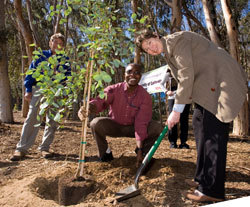Apr 20 2009
Trees absorb carbon dioxide as they grow, providing cooling shade for people and buildings in addition to serving as habitat for birds and other wildlife. But exactly how much can trees reduce an institution’s carbon footprint and save in cooling and other costs? The University of California San Diego, one of the nation’s greenest universities, discovered that the total effect of its 200,000 trees was a reduction of nearly 10,000 tons of carbon dioxide emissions per year, or 5 percent of its annual emissions. The total annual savings attributed to the trees were $2.2 million.
 UC San Diego's campus forester Samuel Oludunfe and Chancellor Marye Anne Fox plant a eucalyptus tree to mark the campus' designation as a Tree Campus USA
UC San Diego's campus forester Samuel Oludunfe and Chancellor Marye Anne Fox plant a eucalyptus tree to mark the campus' designation as a Tree Campus USA
With the April 24 celebration of Arbor Day, the positive impact of UC San Diego’s trees is heartening news for tree-lovers and institutions eager to trim operating costs. The trees help reduce energy use by 12,886 megawatt-hours by consuming solar energy through the process of “evapo-transpiration” and by blocking winter winds, according to the study conducted for the Facilities Management Department at the university. Through direct shade, the trees provide even greater energy-conservation benefits.
The forest study, conducted by Kelaine Vargas, an urban ecologist of Urban Ecos in San Francisco, is the latest component of UC San Diego’s multi-faceted sustainability and climate-change research initiatives. Assessing and reporting the climate impact of urban forests is a new field and few comprehensive studies of individual urban forests have been completed.
UC San Diego was first named a Tree Campus USA by the Arbor Day Foundation in 2008, and the campus marked the recognition by adding 100 trees to its urban forest, including sugar gums, magnolias, and Torrey pines. The campus was one of nine across the country to be honored for promoting healthy urban forest management and for engaging the campus in environmental stewardship.
On this year’s Arbor Day, students and staff will plant sycamores, Torrey pines and Canary pines around campus.
“Trees, as the most dominant green element in any landscape, not only provide spatial definition, but also enhance quality of life by removing air pollutants, reducing energy consumption, facilitating erosion control, fostering community pride, and increasing property value,” said UC San Diego’s campus forester Samuel Oludunfe. “Our urban forest encourages a safer and more sociable ambience, acts as a buffer against noise, supports a myriad of stress-reduction programs, and serves as an educational experience for students, faculty and staff, a living laboratory.”
The energy savings translate into a reduction in the amount of carbon dioxide (CO2) emitted by UC San Diego’s state-of-the-art 30-megawatt natural-gas-fired cogeneration plant. That plant meets about 75 percent of the campus’s peak electrical demand while producing low emissions of nitrous oxide and other pollutants.
The urban forest sequesters another cogeneration-plant byproduct: carbon dioxide. Together, these climate-change benefits result in a reduction of nearly 10,000 tons of carbon dioxide emissions per year, or about 5 percent of UC San Diego’s annual emissions. The total amount of carbon dioxide stored in UC San Diego’s forest is 166,000 tons.
“In UC San Diego’s quest for environmental sustainability, it’s important to measure not only how much greenhouse gas you produce, but also how much you mitigate,” said Steve Relyea, senior vice chancellor for business affairs. “We’re proud of the positive impact of our urban forest, and hope this study highlights for everybody the importance of creating healthy urban forests as a tool to fight climate change.”
UC San Diego’s 1,200-acre campus overlooking the Pacific Ocean is a verdant sea of green. Most of the university’s trees grow in a 112-acre eucalyptus grove. The remainder is a broad mix of 100 species planted along streets and around buildings. In addition to cleaning the air, the campus forest traps and filters nearly 140 million gallons of storm-water runoff each year. The total value of the benefit to air and water by the campus forest is $2.2 million each year, the report said.
UC San Diego’s urban forest provides other environmental benefits that are less easily quantified. For example, when planted to shade parking lots, trees reduce evaporative emissions from cars that would otherwise contribute significantly to poor air quality. Tree shade also helps protect pavement by reducing wear and tear on asphalt. And the trees of the UC San Diego forest support a diverse ecosystem that is home to more than 100 species of birds, small mammals and plants, and serve as a wintering site for the monarch butterfly.
Computer tools used to measure the urban forest’s impact included a tree-carbon calculator developed at the U.S. Forest Service Center for Urban Forest Research. Such accurate measures may eventually lead to urban-forest carbon offsets that could be bought and sold in a cap-and-trade system.
The California Climate Action Registry, of which UC San Diego was a founding member, recently developed a protocol to allow urban forest tree-planting projects to be registered for carbon offsets, and university campuses are one of the eligible entities. This would bring an added incentive to create healthy urban forests.
UC San Diego is also a member of the Chicago Climate Exchange (CCX), North America’s only cap-and-trade system for all six greenhouse gases; CCX also offers a reporting mechanism for measuring forest projects.
“So far, no one has yet traded carbon offsets from urban forests in a cap-and-trade system,” said Kelaine Vargas of Urban Ecos. “But it certainly could be done as soon as standardized protocols and measurements are adopted.”
UC San Diego is a leader in environmental sustainability and climate-change solutions, including sustainable energy development, energy efficiency in information technology, renewable fuels research, atmospheric and ocean research, green research and education opportunities for students, student activism, sustainable practices in housing and dining, green standards for new buildings, and leadership commitment to all of the above.